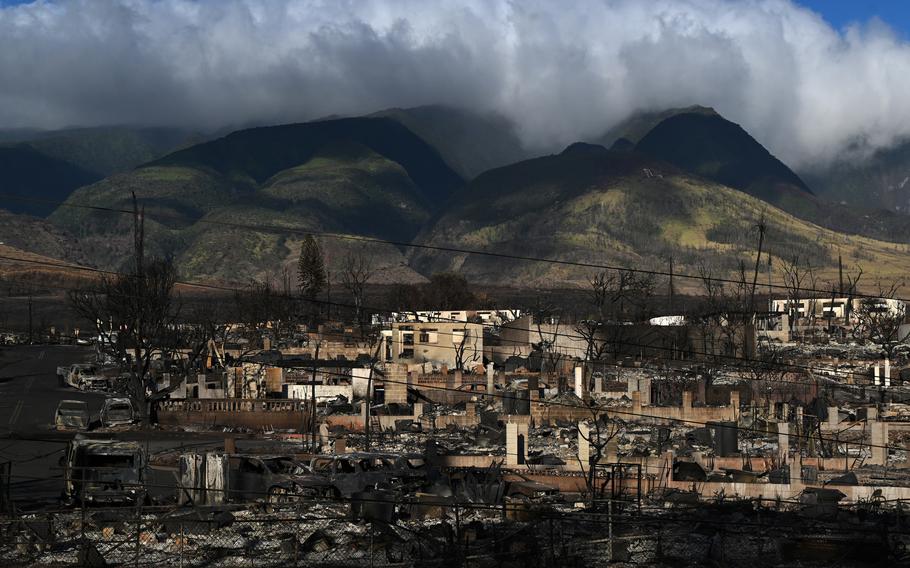
Fire damage in Lahaina on Aug. 13, 2023. (Matt McClain/The Washington Post)
More than 120 hours passed between when President Biden first spoke publicly about the devastating Maui fires on Aug. 10 and his next substantive remarks about the tragedy the following week.
During that five-day stretch of presidential reticence — which Biden spent in part on vacation in Delaware as his son faced fresh legal jeopardy — the full scope of the crisis in Hawaii came into clearer view. The embers of the deadliest wildfires in modern American history left a seaside town completely scorched and caused thousands of grief-stricken survivors to question the competence and capability of the government.
Behind the scenes, aides say, Biden was leading a robust, by-the-book federal response — speaking daily with state officials in Hawaii, ordering federal responders to provide all assistance necessary and receiving detailed briefings as the crisis unfolded. But as the death toll was escalating toward the triple digits, his muted public approach stood in sharp contrast to his long-standing image of an empathetic leader and offered critics a fresh angle to attack him politically.
"No comment," Biden responded Aug. 13 when asked, while he vacationed in Rehoboth Beach, Del., if there was anything he wished to say about the rising death toll in the destroyed town of Lahaina. More than 100 people have now been confirmed dead in the fires and hundreds more remain missing.
It was a rare period of public dispassion from Biden, who has long been seen as uniquely adept at leading with empathy amid tragedies like this one. As the president prepares to visit Maui on Monday to survey the damage and console distraught residents, both his government's response and his personal reaction to the disaster are under intense scrutiny.
"I think President Biden made a mistake not to address the nation about Hawaii in a more forthright, dramatic and immediate fashion," said Douglas Brinkley, a presidential historian and author of a book about the government's handling of Hurricane Katrina. "Just like there's a 72-hour window in rescue and relief, there is also a window when a president can be the great grief counselor in chief. And Biden's usually good at this . . . But for some reason he seemed slow off the mark."
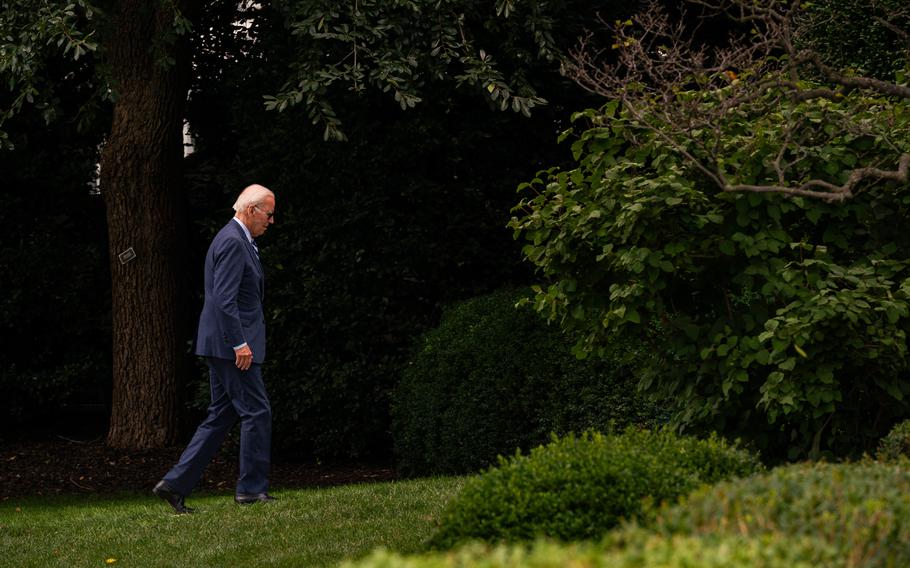
President Biden walks to the Oval Office as he returns to the White House on Aug 14, 2023. (Elizabeth Frantz/The Washington Post)
White House officials counter that the president has been engaged from the outset of the emergency, pointing to the statement he released on Aug. 9 — not long after the fast-moving fires began raging on Maui — and his remarks offering condolences and support the following day. Even when Biden was not publicly active, aides said, he was participating in more than two dozen private briefings and calls over 10 days to stay on top of the situation. Biden approved an emergency declaration for Hawaii just hours after receiving a request from Hawaii Gov. Josh Green, a Democrat who has repeatedly praised the president's actions.
"If President Biden could just teleport himself over, he would've come here in five seconds," Green said on Tuesday. "I've never seen such dedication in a president, who within six hours dedicated his time to determine that this was an emergency, and to commit full repair, full reconstruction for our people here in Hawaii."
But as criticism, largely from Republicans, has intensified over the past week, White House officials have mounted a sweeping effort to showcase the president's personal involvement in handling the crisis.
Shortly after Biden's "no comment" remark a week ago, the White House released back-to-back updates informing reporters that the president had been briefed twice earlier that day by Federal Emergency Management Agency Administrator Deanne Criswell. On Monday, Criswell appeared virtually at the White House briefing room, highlighting Biden's role in dispatching her to Hawaii and otherwise commanding a spirited whole-of-government response. She appeared at the briefing in person on Wednesday.
In an interview, Criswell said Biden had instructed her to clear away bureaucratic red tape and "make sure that I brought every resource that the federal government has" in the assistance effort.
"Take care of these people, Deanne," she recalled him saying over the phone during one of their many phone calls.
Indeed, the federal response effort has been substantial and multifaceted, with FEMA joining agencies including the Defense Department, the Department of Health and Human Services and the Small Business Administration to deliver aid to locals. By Saturday, more than 1,000 federal personnel were on the ground, and the rush of federal aid included thousands of blankets and cots, more than 50,000 meals and cash payments of $700.
With a large military population stationed in Hawaii, the Pentagon dispatched helicopters to fight the blazes, deployed Coast Guard vessels to rescue residents who rushed into the ocean fleeing flames and sent hundreds of troops to move debris from roads. Cadaver dogs trained to search for bodies have accompanied military specialists in remains identification to search through the ash and rubble.
"We've offered whatever support the governor needs," Gen. Mark A. Milley, chairman of the Joint Chiefs of Staff, said in an interview.
Still, amid the immensity of a catastrophe that destroyed more than 2,200 buildings, many locals have complained about a government response they describe as delayed and disjointed. In some communities, Native Hawaiians and other local residents used personal boats laden with generators and other supplies to set up their own relief efforts, stating that FEMA had not yet reached some hard-hit communities on the far-flung island.
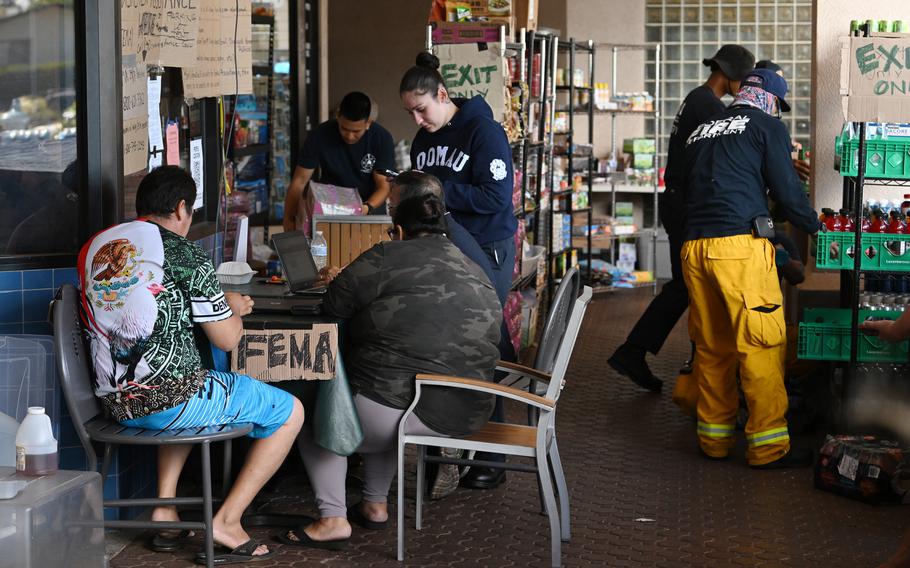
Families fill out paperwork for FEMA relief at Napili Plaza on Aug. 17, 2023, in Napili, Hawaii. (Matt McClain/The Washington Post)
"I feel like the citizens of this island have been called upon, maybe by a higher power, to actually help because no one else is helping," said Kai Lenny, a professional surfer.
From the earliest days of his presidency, Biden had been determined to avoid some of the pitfalls experienced by his predecessors, who saw how a natural disaster can become politically treacherous.
George W. Bush's aloofness during Hurricane Katrina, Donald Trump's callous comments about suffering Puerto Ricans after Hurricane Maria and Barack Obama's detached reaction to the Deepwater Horizon oil spill all came to haunt their presidencies, Brinkley said.
It was not immediately clear as the flames began blazing that Lahaina might add its name to a list of communities marked by presidential-level tragedies. Biden was made aware of the risk of a brush fire as part of a "daily extreme weather memo" from his homeland security team early on Aug. 8, according to a senior White House official, who, like others, spoke on the condition of anonymity to outline the presidential response. Over the next two days, as Biden traveled to New Mexico and Utah, he received several additional briefings about the rapidly spreading inferno.
The president released a statement on Aug. 9, offering his "deepest condolences" and announcing that he had ordered "all available Federal assets on the islands to help." That day, officials in Hawaii confirmed 36 people had died, a number they predicted would rise significantly in the following days.
By the morning of Aug. 10, the scenes of devastation had begun to proliferate more widely and it became clear that Lahaina, a town of 13,000, had largely burned to the ground. Biden addressed the situation at the beginning of a speech about veterans' health care in Salt Lake City that day.
"Our prayers are with the people of Hawaii, but not just our prayers — every asset we have will be available to them," he said.
During the ensuing 120 hours, Biden would unlock additional federal aid for Hawaii with a federal emergency declaration, dispatch top officials including Criswell and Small Business Administrator Isabel Guzman to Maui, speak multiple times with local leaders and pepper his aides with questions about what was happening on the ground.
But publicly, he largely stayed mum, not speaking at length about the tragedy again until a speech the following Tuesday in Milwaukee in which he announced plans to visit the island with first lady Jill Biden.
Biden's extended period of silence came as a political firestorm erupted back in Washington. On Aug. 11, Attorney General Merrick Garland announced he had appointed U.S. Attorney David Weiss, who has been investigating Biden's son, Hunter, for years, as special counsel in the case. Prosecutors said they were prepared to take the younger Biden to trial after a plea deal over allegations of tax and gun-related crimes fell apart.
Even before Garland's announcement, Biden had cut back his interactions with the press considerably. During his four-day trip to Arizona, New Mexico and Utah, Biden mostly ignored questions from the pool of reporters who traveled with him. During a rare exchange with a journalist during the trip, he snapped at a Fox News reporter who had tried to ask him about Republican lawmakers' scrutiny of his son's business dealings.
"I never talked business with anybody," Biden said. "And I knew you'd have a lousy question."
After the interaction, Biden did not substantively engage with the White House press corps again for more than a week. The shift was notable because the president generally has preferred short, impromptu interactions with journalists rather than longer, sit-down interviews or news conferences. Those exchanges, known as gaggles, allow presidents to offer extemporaneous thoughts on the day's news.
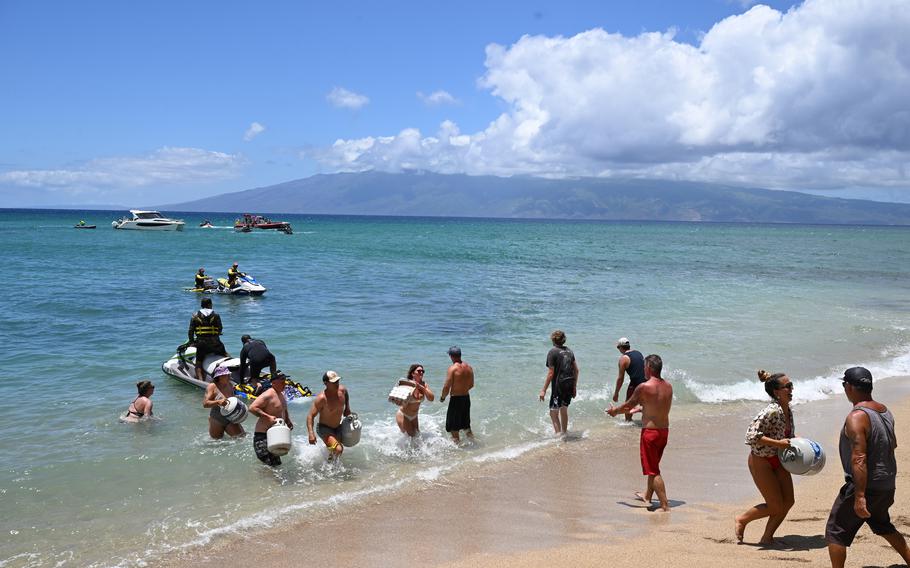
People retrieve propane tanks and other supplies brought in by boats on Aug. 12, 2023, in Kahana, Hawaii. (Matt McClain/The Washington Post)
"We're looking at it," Biden said as he rode his bike past a group of reporters in Rehoboth Beach, Del., on the morning of Aug. 13, responding to a shouted question about whether he planned to visit Maui. He did not stop to elaborate on the comment, which was his most extensive public remark on the wildfires during a three-day stay in Delaware.
Around the same time, residents on Maui were questioning the broader role of the government in the emergency and response effort.
Some wondered why Maui County officials did not activate sirens to warn residents about the approaching flames, while others complained about a lack of water, spotty cellular service and misleading information on social media during the height of the wildfires. The local power utility faced criticism for not shutting off power as strong winds from a passing hurricane buffeted a parched area.
And with hundreds of people still unaccounted for days after the fires smoldered, many survivors complained that the recovery process appeared to be crawling along.
Upon arriving on the scene on Aug. 12, Criswell peered out across an ashen landscape of burned-out cars and buildings in Lahaina and immediately began putting together a report for the president laying out the scope of the damage.
"It's just really hard to put in words, right?" she said. "Because you see it on television, but when you get there and you're standing right in the middle of it, it just really has so much more of an impact."
She sent her memo to Biden the following morning, and the president called her hours later to talk about what she had seen. The two began discussing options for Biden to visit Maui himself, something Criswell said would be helpful for both the president and survivors in need of reassurance.
But, for the time being, the president opted to stay behind the scenes.
Shortly after Biden received the memo from Criswell, he had an opportunity to publicly address its contents when reporters asked him before and after his trip to the beach to talk about what had become the deadliest wildfire in more than 100 years.
Each time he demurred. His response of "No comment" set off a wave of recriminations, largely from Republicans who have been determined to paint him as aloof and out of his depth.
"To say 'No comment' is oftentimes fine, but to be smiling when you say it, especially against such a tragedy as this, is absolutely horrible and unacceptable," Trump said in a video Monday, one of several GOP leaders who attacked the president over the remark.
Biden's allies noted that many of the attacks were nakedly political and came from people who deny climate change despite evidence of increasingly frequent and intense natural disasters. They also pointed to messages he posted on social media about the disaster the morning after declining to comment.
Still, the president had opened the door to the criticism by remaining silent for so long, a decision that was out of step with his usual approach to publicly dealing with grief, said Barbara Perry, a presidential historian at the University of Virginia's Miller Center.
"Because President Biden has suffered so many personal tragedies in his life, his genuine empathy and sympathy for fellow victims have made him an extraordinary consoler in chief," she said. "Which makes his slow response to the Maui fires puzzling."
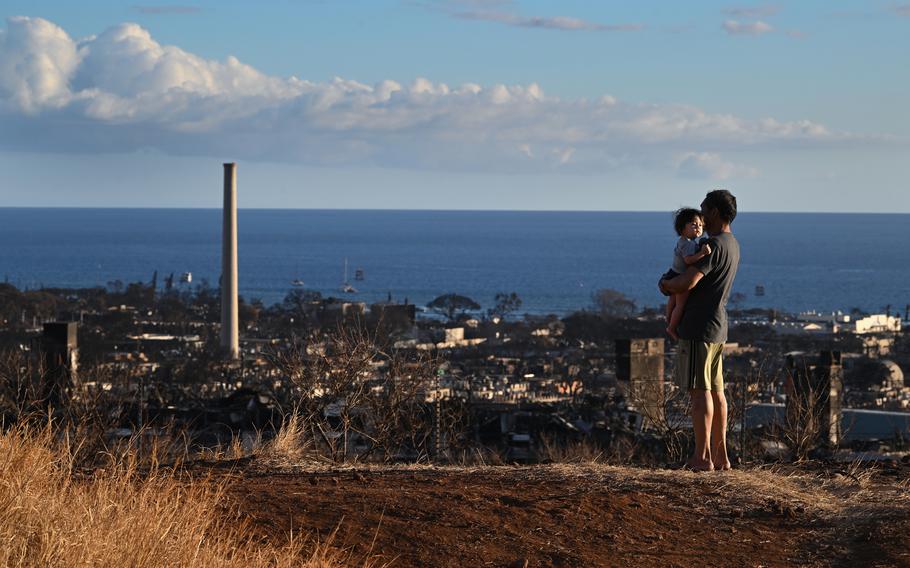
A man and child look at fire damage in Lahaina, Hawaii, on Aug. 13, 2023 (Matt McClain/The Washington Post)
Biden pledged during his campaign that his presidency would offer a fresh break from his predecessor, both in terms of competency and empathy. He has often sought to showcase those twin traits when managing natural disasters.
Aides say many of the lessons learned from natural disasters in 2021 have led to operational changes that have helped his administration respond more seamlessly to increasingly frequent extreme weather events caused by climate change. For example, FEMA often pre-deploys assets to an area in advance of a potential disaster, making recovery efforts less cumbersome on the back end.
One senior White House official said that they can often "intuit" what Biden will ask or direct during a catastrophe, based on experiences dealing the aftermath of floods, fires and hurricanes over the past two years.
"It's not like we have to build this from scratch," the official said. "We already have the system built and we know the president's intent."
Sen. Mazie Hirono (Hawaii), one of several Democrats who have publicly praised the Biden administration's response, recently characterized the assistance as "incredibly helpful." Her first call from the administration came early the morning of Aug. 9, just hours after the fires started in Maui, from Homeland Security Secretary Alejandro Mayorkas, who told her that the agency would cover any fire fighting costs incurred.
When Biden called her two days later, he offered his full support to help rebuild Hawaii and pledged he would go visit once it became clear that his trip would not serve as a distraction to ongoing rescue efforts.
Ahead of his visit, Biden has sought to reassure Hawaii residents that his administration is fully committed to supporting the island through the expensive recovery process. He informed Green in a phone call Wednesday that the federal government would reimburse 100 percent of cleanup and recovery efforts for 30 days.
On Thursday, the president appeared on ABC's "Good Morning America" to deliver a recorded video address to survivors.
"We'll be with you for as long as it takes, I promise," he said. "I want the people of Hawaii to know, your country's with you."
Marianna Sotomayor, Matt Viser, Tyler Pager, Reis Thebault and Leigh Ann Caldwell contributed to this report.